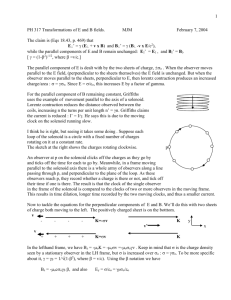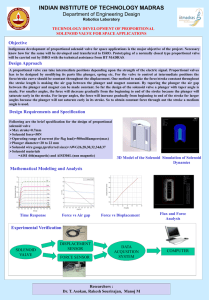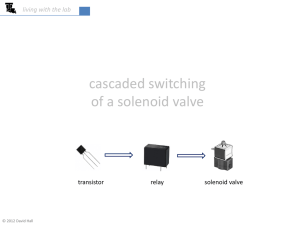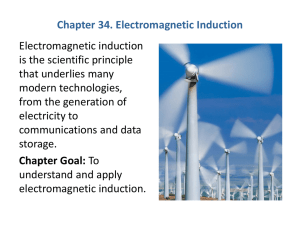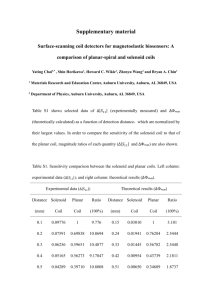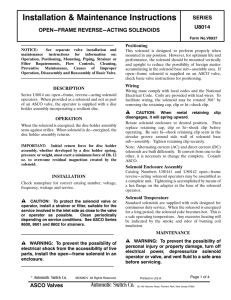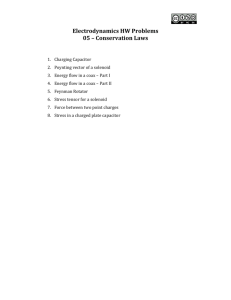Selection of Push-Pull Solenoid
advertisement
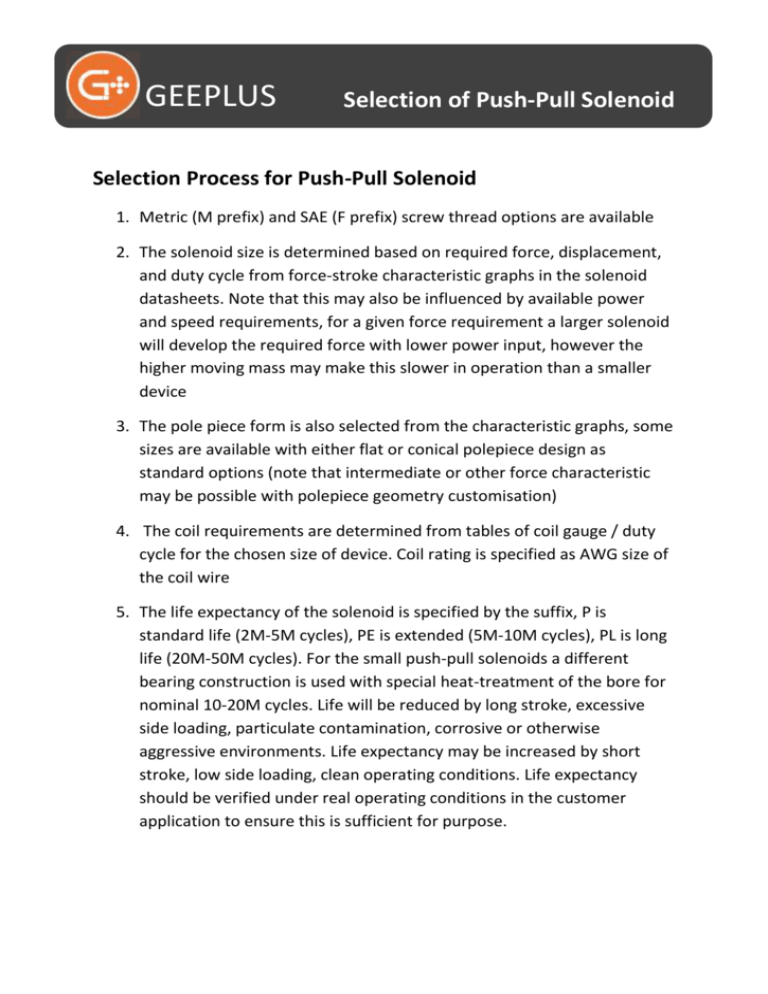
GEEPLUS Selection of Push-Pull Solenoid Selection Process for Push-Pull Solenoid 1. Metric (M prefix) and SAE (F prefix) screw thread options are available 2. The solenoid size is determined based on required force, displacement, and duty cycle from force-stroke characteristic graphs in the solenoid datasheets. Note that this may also be influenced by available power and speed requirements, for a given force requirement a larger solenoid will develop the required force with lower power input, however the higher moving mass may make this slower in operation than a smaller device 3. The pole piece form is also selected from the characteristic graphs, some sizes are available with either flat or conical polepiece design as standard options (note that intermediate or other force characteristic may be possible with polepiece geometry customisation) 4. The coil requirements are determined from tables of coil gauge / duty cycle for the chosen size of device. Coil rating is specified as AWG size of the coil wire 5. The life expectancy of the solenoid is specified by the suffix, P is standard life (2M-5M cycles), PE is extended (5M-10M cycles), PL is long life (20M-50M cycles). For the small push-pull solenoids a different bearing construction is used with special heat-treatment of the bore for nominal 10-20M cycles. Life will be reduced by long stroke, excessive side loading, particulate contamination, corrosive or otherwise aggressive environments. Life expectancy may be increased by short stroke, low side loading, clean operating conditions. Life expectancy should be verified under real operating conditions in the customer application to ensure this is sufficient for purpose. Size Determination Device size is determined for the required force, displacement, and duty cycle from the tables below, more detailed force data is shown graphically in the datasheet for each solenoid. These charts show force at maximum useful stroke (the stroke at which force falls to 10% of the holding force at 0mm position) for 100% or 10% duty excitation Force at 100%ED and 10%ED at Maximum Useful Stroke 1000 100 10 1 0.1 0.5 5 M/F191F M/F401F M/F591C M/F191C M/F401C M/F700F M/F250F M/F490F M/F700C M/F250C M/F491F M/F870F M/F301F M/F491C M/F870C M/F301C M/F590F M/F874F M/F341F M/F590C M/F874C M/F341C M/F591F Force at 100%ED and 10%ED at Maximum Useful Stroke 100 10 1 0.1 0.1 1 M/F110C M/F141C M/F144C M/F190C M/F192C M/F221C M/F224C M/F251C M/F300C M/F304C M/F194C Specifying Coil AWG Duty Cycle 100% 50% 25% 10% Maximum 'ON' time Watts at 20º C ampere-turns at 20º C AWG no Resistance no. turns ∞ 100 36 7 7 14 28 70 425 602 849 1350 26 27 28 29 30 31 32 Nominal Voltage 1.96 231 3.5 5 7.1 11 3.16 296 4.5 6.3 8.9 14 5.1 378 5.6 8 11 18 6.94 423 7.1 10 14 22 11 530 8.9 13 18 28 16.9 649 11 16 22 36 28.3 858 14 20 28 45 The coil AWG is determined from tables of coil data for the given part, in the column corresponding to chosen duty cycle, the voltage closest to user supply is picked, and coil AWG corresponding to this is indicated in the LH column (example shows selection for a part operated from 12v supply at 25% duty cycle) o In the example illustrated, the selection of a device having higher nominal voltage than the supply is conservative, for maximum torque and speed the 28AWG coil might be more appropriate (see also point below) o Allowance should be made for voltage drops in switching devices, and resistive drops in wiring harness when determining the nominal voltage which will be applied to the solenoid Customisation of the Push-Pull Solenoid Most of the attachment components of the push-pull solenoid are produced by machining and are amenable to modification even in small (100’s or less) quantity. Some typical examples are illustrated below. 1. 2. 3. 4. Flats and cross-hole machined in shaft at armature side Grooves machined in shaft at base side Shaft decoupled from plunger by spring, maintenance-free bearings Modified plunger with shallow angle for increased force at extended position, shaft hardened with sphere end on base side tapered on armature side, and lead wire assembly with connector 5. Screw threads machined on shaft on armature side 6. Mounting plate, bronze bush pressed on shaft, custom lead assembly 7. Modified armature with flat sides and threaded holes, no shaft Mechanical modifications are best described with a sketch or drawing, when defining dimensions along the axis these are normally defined relative to the base plane of the solenoid, and described with reference to major components as described below.
